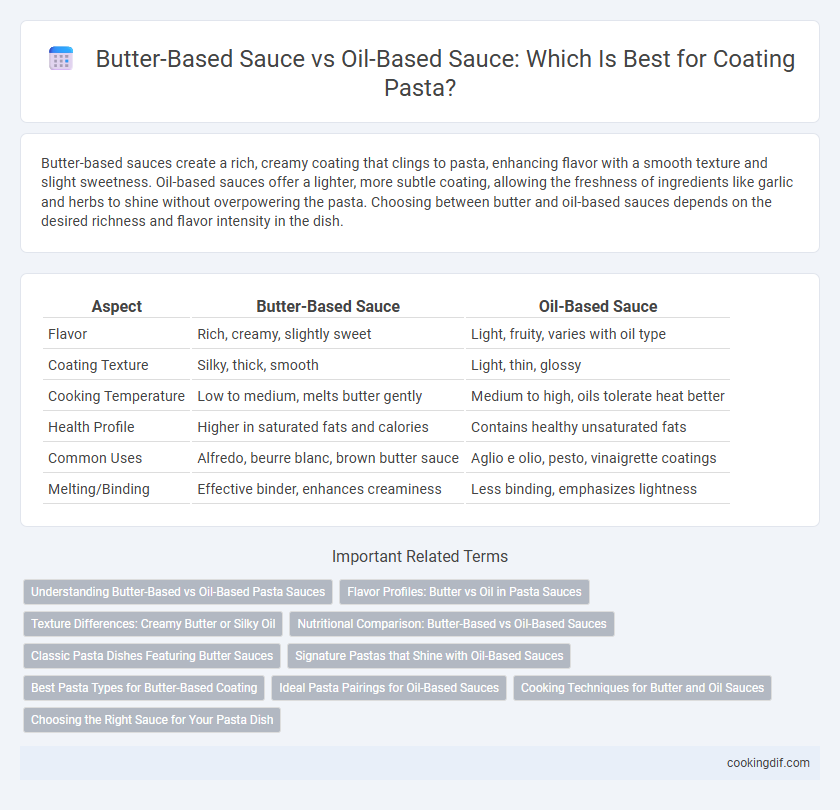Butter-based sauces create a rich, creamy coating that clings to pasta, enhancing flavor with a smooth texture and slight sweetness. Oil-based sauces offer a lighter, more subtle coating, allowing the freshness of ingredients like garlic and herbs to shine without overpowering the pasta. Choosing between butter and oil-based sauces depends on the desired richness and flavor intensity in the dish.
Table of Comparison
| Aspect | Butter-Based Sauce | Oil-Based Sauce |
|---|---|---|
| Flavor | Rich, creamy, slightly sweet | Light, fruity, varies with oil type |
| Coating Texture | Silky, thick, smooth | Light, thin, glossy |
| Cooking Temperature | Low to medium, melts butter gently | Medium to high, oils tolerate heat better |
| Health Profile | Higher in saturated fats and calories | Contains healthy unsaturated fats |
| Common Uses | Alfredo, beurre blanc, brown butter sauce | Aglio e olio, pesto, vinaigrette coatings |
| Melting/Binding | Effective binder, enhances creaminess | Less binding, emphasizes lightness |
Understanding Butter-Based vs Oil-Based Pasta Sauces
Butter-based pasta sauces provide a rich, creamy texture that enhances the pasta's flavor with a smooth mouthfeel, ideal for delicate ingredients like fresh herbs and light cheeses. Oil-based sauces, typically made with olive oil, offer a lighter, slightly fruity taste and a glossy finish, perfect for robust ingredients such as garlic, chili flakes, and vegetables. Both sauce types effectively coat pasta, but choosing between butter and oil depends on the desired flavor profile and ingredient pairing for the dish.
Flavor Profiles: Butter vs Oil in Pasta Sauces
Butter-based sauces for pasta offer a rich, creamy flavor with a subtle sweetness and smooth texture that enhances the overall taste. Oil-based sauces, often using olive oil, provide a lighter, fruitier, and slightly peppery profile that allows the natural ingredients to shine. Both options influence the mouthfeel and aroma distinctly, with butter delivering a luxurious mouth-coating sensation and oil creating a fresher, more delicate finish.
Texture Differences: Creamy Butter or Silky Oil
Butter-based sauce creates a rich, creamy texture that clings smoothly to pasta, enhancing its flavor with a velvety mouthfeel. In contrast, oil-based sauce offers a lighter, silky coating that allows each strand to remain distinct and less heavy. The choice between butter or oil significantly impacts the pasta's overall texture and taste profile.
Nutritional Comparison: Butter-Based vs Oil-Based Sauces
Butter-based sauces contain higher saturated fats and cholesterol, contributing to richer flavor but increased heart disease risk. Oil-based sauces, especially those made from olive or avocado oil, provide healthier monounsaturated fats and essential antioxidants that support cardiovascular health. Choosing oil-based sauces can enhance nutrient absorption and offer anti-inflammatory benefits compared to butter-based alternatives.
Classic Pasta Dishes Featuring Butter Sauces
Classic pasta dishes featuring butter-based sauces include Fettuccine Alfredo, where creamy butter and Parmesan create a rich coating that clings perfectly to the noodles. Butter sauces provide a silky texture and subtle sweetness that enhances the flavor of delicate pasta varieties like linguine and tagliatelle. Unlike oil-based sauces, butter-based coatings deliver a smoother mouthfeel and a more luxurious taste experience.
Signature Pastas that Shine with Oil-Based Sauces
Signature pastas that shine with oil-based sauces, such as aglio e olio or puttanesca, emphasize the vibrant flavors of high-quality olive oil infused with garlic, herbs, and spices. These sauces provide a lighter, more aromatic coating compared to butter-based options, allowing the pasta's texture and ingredients like anchovies, capers, and chili flakes to stand out. Oil-based sauces also offer a refreshing contrast that enhances the natural taste of fresh pasta or al dente varieties commonly used in Italian cuisine.
Best Pasta Types for Butter-Based Coating
Butter-based sauces create a rich, creamy coating ideal for delicate pasta shapes like fettuccine, tagliatelle, and pappardelle, which absorb the sauce's velvety texture perfectly. These flat, broad noodles maximize flavor adherence compared to thinner options, enhancing the buttery essence. Unlike oil-based sauces that coat more evenly on twisted or tubular pastas, butter-based sauces excel with ribbons that allow the sauce to cling smoothly, resulting in a luxurious mouthfeel.
Ideal Pasta Pairings for Oil-Based Sauces
Oil-based sauces, such as aglio e olio and pesto, pair best with long, thin pasta shapes like spaghetti, linguine, and bucatini, as their smooth texture allows the sauce to cling evenly. The light, unctuous nature of oil-based sauces complements fresh herbs, garlic, and Parmesan cheese often found in these preparations, enhancing the pasta's flavor without overpowering it. This pairing ensures a balanced bite where the sauce lightly coats each strand, offering a clean yet flavorful experience ideal for simple, fresh ingredients.
Cooking Techniques for Butter and Oil Sauces
Butter-based sauces require gentle heat to prevent browning and preserve a creamy texture, often finished off by emulsifying with pasta water for a smooth coating. Oil-based sauces benefit from infusing flavors into the oil at moderate heat before tossing with pasta to evenly distribute taste and moisture. Mastering temperature control and timing is essential for both techniques to achieve optimal coating and texture in pasta dishes.
Choosing the Right Sauce for Your Pasta Dish
Butter-based sauces provide a rich, creamy texture and enhance the pasta's flavor with a subtle sweetness, ideal for dishes featuring delicate ingredients like seafood or vegetables. Oil-based sauces, often made with extra virgin olive oil, deliver a lighter, more aromatic coating that preserves the integrity of robust or spicy components such as garlic, chili flakes, or herbs. Choosing the right sauce depends on the pasta type and accompanying ingredients, balancing richness and flavor intensity to create a cohesive and satisfying dish.
Butter-based sauce vs oil-based sauce for coating Infographic

 cookingdif.com
cookingdif.com